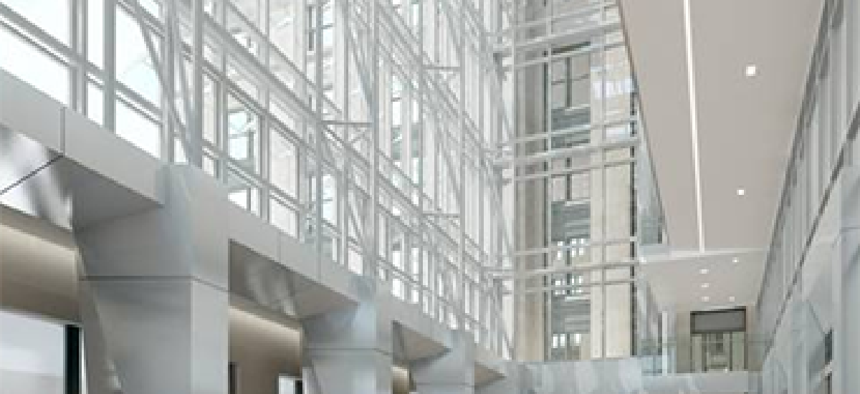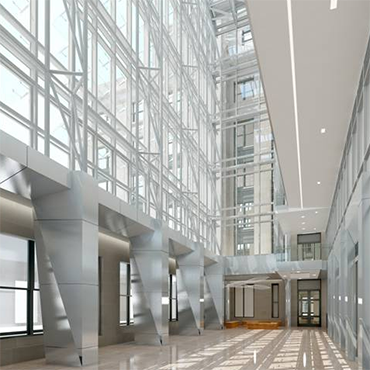Contractors critique GSA's new workspace

GSA's remodeled headquarters is designed to accommodate a flexible, connected workforce. Some contractors, however, are finding the transition difficult.

The atrium of GSA's headquarters building. (GSA photo)
GSA's transformation of its F Street NW headquarters in Washington into a consolidated, flexible and open workspace for its employees is causing some headaches for federal contractors.
Most appear to be the kinds of short-term glitches associated with any new office, but a few of the changes have some contractors worried about longer-term consequences.
An informal poll by Larry Allen, president of Allen Federal Business Partners, through his weekly newsletter for federal contractors, showed that respondents "overwhelmingly" found it more difficult to reach contract specialists and contracting officers as the first phase of GSA's consolidation of three offices into its F Street location nears completion. Allen conducted the poll during the last week of August and reported the findings the week of Sept. 23.
Telephone interviews with a handful of contractors and consultants tended to back the assertion that communications between GSA contracting personnel and private contractors have been complicated by the new office and work structure.
The contractors FCW talked with said they didn't expect the difficulties to continue long-term and chalked it up primarily to the administrative pains associated with a new work environment.
GSA workers began moving into newly renovated space at the 1800 F St. headquarters building in May and are slated to complete the move by Oct. 1.
More than 3,000 GSA employees will ultimately call the building home when the move is finished. Previously, the F Street headquarters held 2,200 employees. The additional employees came from other leased GSA building in the Washington area and include employees from the Federal Acquisition Service (FAS) and Public Building Services (PBS).
The newly renovated space aims to open up the physical work environment with specified task-oriented work zones, a minimal number of enclosed offices, shared office spaces and an emphasis on telework to increase office space efficiencies and save money by eliminating old leases on other properties. Overall, GSA hopes to save $24 million annually with increased use of mobility technology, telework and desk sharing.
GSA Administrator Dan Tangherlini has said FAS and PBS employees, who work in bullpen areas in the building, have access to glass-enclosed quiet rooms for private meetings and telephone conversations.
There are some concerns among government contractors about the new workspace and telework arrangements, though. Some have said they had issues communicating with teleworking contracting officers, but also with scheduling time in private rooms and privacy concerns at the building itself.
"Whether or not the consolidation is actually the issue, respondents overwhelmingly said that it is now more difficult to reach contract specialists and contracting officers, that modifications and renewals are taking longer, and that the frustration level of contractors is on the rise," Allen wrote in his newsletter.
Allen chalked up some of the concerns to the initial consolidation, but he and some of the contractors said there could be signs of a longer-term problem.
There isn't a shortage of space at the headquarters building, said a GSA spokesperson in statement to FCW, with 232 private spaces available for use. More than 150 of those rooms, said the spokesperson, are easy to book ahead of time, and 80 are available with no reservations needed.
"With all of these spaces available, employees and contractors alike can choose which accommodations best suit their needs to complete their work. There is no shortage of private space," the spokesperson said.
Contractors said they had experienced problems in meetings with contracting officers who had improperly scheduled, or had not made, meeting room reservations, resulting in meetings having to be moved at the last minute or after they had begun. Another said it had taken days to reach a teleworking contracting officer.
Some also noted that the open floor plan allows everyone to see almost everyone else, including competing contractors. That leads to a possibly longer-term concern — a reduction, or perceived reduction, in privacy for sensitive bid information. Glass walls in meeting rooms, said one contractor, could mean a competitor could either inadvertently or purposefully see proprietary information in a bid or other document. It would also visually expose competitive bidding teams to each other as they moved through or met with GSA contracting officers, possibly allowing a competitor a better assessment of what might be in a bid because of which company officers are present.
One contracting consultant said those issues were a concern in GSA's old leased spaces as well, with their cubicle farms and paper binders of contract information lying on shelves. The problem, he said, lies in the use of paper-based contracting processes, not in how offices are laid out.
Most of the contractors interviewed were willing to assume – for now – that the difficulties are a result of adapting to a new work environment. "This is a transition period. Inevitably things are going to happen," said one.
They also acknowledged that the agency probably isn't going to go back to the way things used to be, although the private sector holds at least one prominent example that challenges that theory.
Yahoo!, a pioneer of alternative work arrangements, made headlines last February when CEO Marissa Meyer rescinded her company's telework policy and ordered employees back to the office.
NEXT STORY: Technology lends a twist to shutdown scenario


